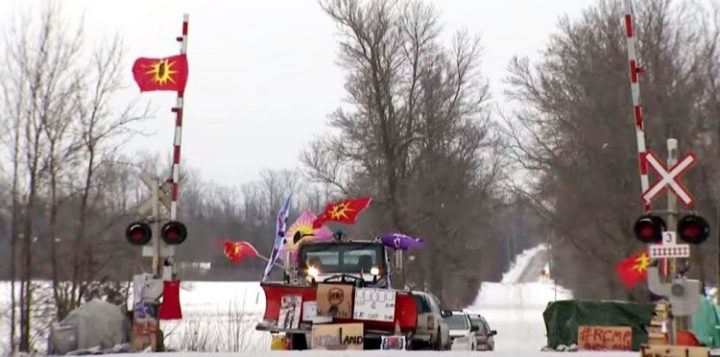On Monday, police were clearing away Mohawk demonstrators who have blocked rail traffic on one of Canada’s most vital routes for the past 18 days, as threats break out of further protests in support of Wet’suwet’en hereditary chiefs.
As television stations in Canada played video of arrests at the Tyendinaga Mohawk blockades near Marysville, Ontario hundreds of activists held a solidarity protest that began on Parliament Hill and crawled through downtown Ottawa.
At the same time, protesters from the Mohawk community in Kahnawake, Quebec — where activists have held their own rail blockade since February 8 held a slow-moving demonstration on a highway leading into Montreal.
Speaking to reporters on his way to meet with the government’s incident response group, Public Safety Minister Bill Blair said the barricades on rail lines “cannot persist” because they are having an unacceptable “negative impact on Canadians across the country.” (TheStar)
The Mohawk condemned the use of force being used in Tyendinaga Mohawk Territory on people who are standing up for human rights and the land and water. The rule of law includes human right and Indigenous rights. The international Convention for the Elimination of Racial Discrimination condemns colonization which Canada practices through the Indian Act. Canada is a signatory to the ICERD (International Convention on the Elimination of All Forms of Racial Discrimination).
Political and public rhetoric about the “rule of law” has been invoked by those who support and those who oppose the protests. As Canadians work through these competing positions, an understanding of the constitutional freedom of peaceful assembly can offer some clarity. Protected under section 2(c) of the Canadian Charter of Rights and Freedoms, freedom of peaceful assembly is one of our most fundamental – and ignored – constitutional rights. (TheGlobalMail)
Protests raise some of the most important and thorniest questions at the intersection of constitutional rights and politics in a democratic society. These questions can get mired in confusion due to a common misconception: that freedom of peaceful assembly is the same as freedom of expression. But freedom of peaceful assembly is different from freedom of expression (protected by section 2(b) of the Charter). The former protects expression that takes a particular form (assembly) and is exercised collectively. Equal freedom of expression alone is not enough to permit all perspectives to compete fairly in the “free marketplace of ideas.” Rather, unequal distribution of wealth and social standing amplifies some voices and silences others. In short, freedom of peaceful assembly gives marginalized groups a way to make themselves heard. (TheGlobalMail)
Environmental Assessment refusal
British Columbia has ordered the energy company behind the Coastal GasLink pipeline to go back and carry out more consultations with Wet’suwet’en hereditary chiefs before it can proceed. The province’s Environmental Assessment Office (EAO) has refused a key report from the company, which is required before Coastal GasLink can get its final green light for construction in Wet’suwet’en territory. (The National Obverser)
The company has 30 days to carry out more consultations with Wet’suwet’en community.
Yves-François Blanchet, Bloc Québécois chief and major Québec opposition on Parliament Hill in Ottawa pointed out on Sunday that the British Columbia Environmental Assessment Office’s (EAO) request was known on Friday when Justin Trudeau called for respect for the law and the lifting of barricades. Blanchet said the Prime Minister should have used it as leverage to force dialogue since the assessment was dated February 18th. (TVA Nouvelles)
“Rather than referring to the suspension of work, the Prime Minister of Canada once again hid behind the police forces of the provinces and Quebec,” said Mr. Blanchet in an interview with TVA Nouvelles. It’s the opposite of the type of initiative you have to take. We must not threaten to use force when there is a great openness at present to have favorable conditions for negotiations. “(TVA Nouvelles)
Since the Prime Minister’s exit from the rail crisis on Friday, neither of the two largest barricades, that of Tyendinaga, east of Belleville, Ontario, (lifting up by police on Monday) and that of Kahnawake, on the South Shore of Montreal, has been lifted, and sympathy demonstrations continue to take place in various locations across the country.










